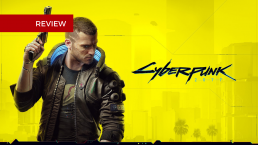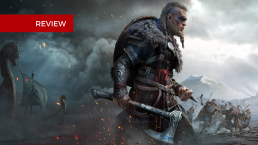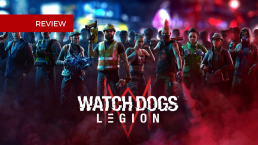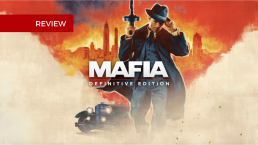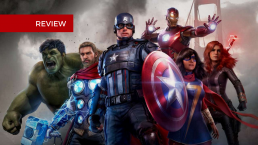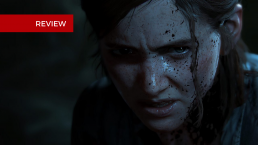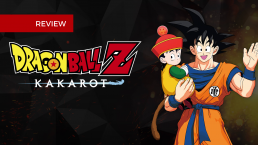Review | Cyberpunk 2077
It's hard not to dwell on the beautiful images that Cyberpunk 2077 constantly presents you. Night City, the city where most of the game takes place, feels alive and very real. The architecture, the horizon: it looks like a city with a history. A city where buildings and streets are built on the remains of previous constructions, and where roads and alleys wind organically around existing structures.
The way the story is propelled, whether in the main mission or in the many, many optional side missions, is fantastic. Conversations give you information organically, and during those conversations you make choices that actually affect later events and even the end of the game. The choice of your life path as the mercenary V , Corpo, street rascal or Nomad, at the start of the game not only determines how the game starts for you, but also gives you dialogue options that suit your background.
Just like in most modern RPGs, completing a mission consists of several stages, in which you have to make all kinds of choices. Many missions consist of “heists”, complicated infiltrations where you stealthily, fight or hack to reach a goal. You decide how to tackle a problem at any time. For example, it is often possible to complete missions without firing a shot, which is not only blood-curdling, but also very satisfying. You use your common sense instead of your weapons. However, if you just want to knock things over, you can of course do as you please.
Finally, hacking is primarily a useful tool that adds an interesting puzzle element to confrontations with enemies. The hacking itself is not very challenging, it’s in fact nothing more than a kind of maze that you have to solve by selecting letter-number combinations before the time runs out. Once something or someone is hacked, on the other hand, new doors open to deal with a situation.
Somewhere early in the game, a gigantic, heavily armed cyborg, for example, seemed almost impossible to defeat. But by hacking him before the fight, there was suddenly the option of either blinding him, making his giant arm cannon a lot less effective, or knocking out half of his life meter with a powershortage.

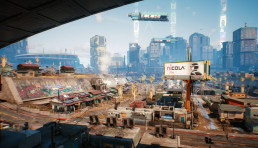
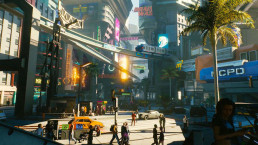
Fighting as well as sneaking are not without problems. Well, “problems” may be a bit heavily phrased, but Cyberpunk 2077 is pretty forgiving on that front. When an enemy spots V, you have a few seconds to move out of sight again. Which is remarkable, given that the vast majority of opponents have cybernetically enhanced eyes.
The same is true to some extent for gunfights. You can do a lot of damage even in the beginning of the game and it is by no means always necessary to move tactically from cover to cover to win a fight. In fact, when an enemy is hiding behind a pillar, it’s a lot more effective to run up to it and shoot a shotgun in the face a few times.
Fortunately, that tactic doesn’t always work, and when there are many enemies in the area, it’s certainly possible to quickly go “flatline”, Cyberpunk 2077’s version of a game over-screen. Which also immediately causes another minor annoyance: checkpoints do not always make sense. For example, in a given mission, the game saves before a long dialogue scene, which is followed by a spirited firefight. So it is not possible to manually save the game during a battle or a dialogue. Having to go through the same scene with interactive options multiple times therefore diminishes its emotional impact.
Fortunately, there is a feeling of excitement and fun during most of the game. Especially when the first act is over and you meet Johnny Silverhand, the virtual rock star who is suddenly implanted in your brain due to circumstances. Johnny acts as your side kick in the same way that The Joker was in Batman: Arkham Knight. He shows up to comment on you and the situation and usually acts like an amusing bastard.
It’s also thanks to Johnny that Cyberpunk 2077 elevates itself to a game that truly belongs in the cyberpunk genre. Because to be “real” cyberpunk, it is not enough to create a technological city with implants and virtual reality. The great strength of the genre is that this dystopian vision of the future poses interesting questions about what it means to be a human, and about life and death. And especially by adding alienating elements. The character Johnny, played brilliantly by Keanu Reeves, is the epitome of those traits. From the moment Johnny gets into “your” head, Cyberpunk 2077 transforms from “a game of cyberpunk decoration” to something with a strong identity of its own.
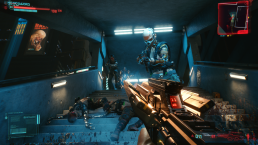
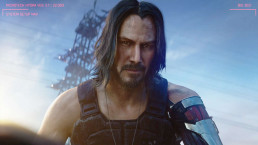

Cyberpunk 2077 is basically a standard role-playing game with stats, levels, skill upgrade points and a quest log full of missions that you collect along the way.
Missions are classified by “danger level”, which basically shows if your level is high enough to survive them. There are extremely many of these side missions to be found. Of course, there are a lot of trivial activities, such as taking out criminals for their bounties or collecting objects, but many of the “real” side missions are just as extensive and full of surprises as the main story. In that respect, we again see the philosophy of the studio that brought us The Witcher 3: side missions are actually the reason to play. The main story itself is not very long. It is possible to complete it in twenty hours by ignoring most of the side paths.
Although there is a certain routine in tackling missions (sneak, fight, hack your way through a location) the game isn’t predictable. In addition to the fact that later upgrades change your playing style substantially, there are also all kinds of trips that refresh things considerably. Trips such as an underwater mission and various “brain dances”, where you step into a memory and play a kind of mini adventure game to collect clues, provide plenty of unpredictability. Most missions also have certain surprises, where you suddenly have to solve a puzzle unique to that mission.
The game did not crash with us, but there are some small bugs. The day one patch should fix a lot, and given the extensive support for The Witcher 3, it’s not unreasonable to expect Cyberpunk 2077 to be near bug-free in a few months. Which makes it feel like it might be a bit of a shame to play the game right now. But yes, the hype and all that. This is such a game that many people look forward to and want to get into as soon as possible.
Hype is a bad counselor. Looking forward to a game for eight years will give that game a mythical status that it can never live up to. That doesn’t mean it is bad. Cyberpunk 2077 is a really, really good RPG in a great world.
Score:
9,0
+ Lots of variety
+ Lots of good story missions
+ Great graphics
– Unnecessary bugs
Review | Spider-Man: Miles Morales
Spider-Man has always been with the themes as a formula. This is no different in this spin-off, which revolves around Miles Morales, a young man whose mother fights in politics against corrupt politicians and rogue companies. The central theme is electricity. You notice it in the story, but also in Miles Morales himself, electricity is what distinguishes him most from Peter Parker.
Miles can energize his body with “venom”, a kind of orange lightning. With venom, he can hurl enemies through rooms, make them immobile, or simply provide them with an electric shock. He also uses electricity in puzzles. Miles needs, for example, to charge generators or connect electricity networks to venom.
Electricity also plays a major role thematically. A new energy company, Roxxon, appears to have a very big say in New York City’s work. Roxxon’s motives therefore seem double. Miles’s mother, who still has to recover from the loss of her husband in the first part, therefore turns to politics.
There is therefore a lot, um, tension (see what i did there :p ) between the family members. And then there is Miles’s best friend, who, together with her brother and Miles herself, is closely involved in the development of new technology. They are working on a new form of energy that could replace electricity: NuForm.

The story in Spider-Man: Miles Morales is a bit silly, but the game gets away with that because even the somewhat silly narrative brackets remain entirely within the acceptable comic book spectrum. This game contains some strong and genuinely emotional narrative moments. Developer Insomniac Games does that very well. Miles Morales goes through bizarre things, but feels more human than superhero.
Peter Parker doesn’t play a big role in this story, if you think that after the trailers. He is going on vacation with his now well-known girlfriend, and so Miles, for the first time, has to take over from him for a week or two.
This part was therefore completed much earlier than the original. You’ll be through it within twelve hours, but it feels much faster. The pacing is very high and exciting turns follow each other in rapid succession. It is therefore difficult to put the controller down. Compared to the original Marvel’s Spider-Man, Miles Morales feels trim. After completing the game, you can still play the friendly neighborhood hero. Miles has his own app that residents can use to call on him. It is an ingenious alternative to a quest system.
Also interesting are the special powers that Miles has. The normal combat, against normal enemies, was a bit more aggressive in the previous part, given Miles has invisibility and Peter Parker had some strong area-of-attack attacks. Perhaps the subtlest difference between the two games is the music. Miles Morales leans a little more towards hip hop. Beats are mixed through the symphonic orchestral music, which you hear well during fights, among other things, a subtle but appropriate addition.
Spider-Man: Miles Morales will be released on the PlayStation 4, but also on the new PlayStation 5. This game is very nice on the PlayStation 5, partly thanks to ray tracing. You play at 30 fps. Without ray tracing, the game runs at 60 fps.
There is a time when ray tracing almost perfectly is on display . You then enter an enemy base under supervision. The hallway is infused with purple lighting and flashing monitors with an Outrun-esque aesthetic. In this shot, the lighting reflects on the shiny coats, but especially on the floors.
Ray tracing also gets the literal opportunity to shine on the windows of flats and in the well-placed rain puddles. Whether all of that justifies the loss of 60 fps is personal. I don’t think so. That high frame rate is really nice, especially during the hectic fights. But you have to make that decision yourself.
In the game you don’t notice much of the new adaptive triggers, although they do make sure that you have to press “harder” while spinning through the city, a great effect. The haptic feedback is not very impressive either. You only really notice when very heavy enemies thunder through the image, such as an enemy of rhino-like proportions.
Whether you play this game on the previous or the new PlayStation, Miles Morales is very rewarding. It tells a concise yet intense story, introduces some really entertaining twists, and there’s a lot to collect, solve and battle out in New York.
Score:
9,0
+ Very entertaining storyline
+ Beautifull and vivid game world
+ Ray tracing showcases beautifully
– Faster finished than hoped
Review | Assassin's Creed Valhalla
Can a game be too big? Ask anyone who played Assassin's Creed Odyssey and the answer is probably yes. Not only the game world was immense, the game itself was bursting at the seams with the amount of weapons, gear, skills, upgrades for your boat, mercenaries and cultists. Fortunately, Ubisoft has pulled out the trimmer for Assassin's Creed Valhalla, in a good way.
In Assassin’s Creed Valhalla you take on the role of Eivor and choose whether you play as a male, female or let the Animus decide for you. A completely cosmetic choice that does not change the course of the game. But because I played as a male Eivor, I refer to “him” in this review. Eivor is one of the many Vikings who left Scandinavia at the end of the ninth century and tries to settle in England.
Medieval England relied more on its natural beauty than its prominent landmarks, for even London at the time was little more than a peasant settlement built on Roman ruins. Despite its primitiveness, England at that time was a powder keg that was about to explode. The country is divided into four different kingdoms. Foreign invaders, such as Eivor, are increasing tensions. Of course The Order of the Ancients appears to be pulling all kinds of strings in the background. Before Eivor knows it, he is involved in a plot that is much bigger than his own ambition to build a settlement.
That sounds like run-of-the-mill Assassin’s Creed material, but Valhalla does a number of things significantly differently from its predecessors. Take, for example, the way the story is divided. Valhalla consists of clear Arcs, which are also presented as such. Each story arc has a clear beginning and end and always focuses on a specific area. In one story arc you have to help a local king stay in power and you fight in great battles in which you storm a castle in stages. Another storyline takes more inspiration from the classic Assassin’s Creed and relies on detective work and assassinations with the Hidden Blade.
Story missions follow each other relatively quickly within such a story arc, without the player being distracted all the time. Side missions and activities are still plentiful and you are free to undertake them whenever you feel like it, but it feels more natural to explore the land in between those story arcs. In addition, side missions no longer “pollute” your quest list: they are really meant to be done immediately and quickly in between. This creates a nice balance of playing missions, exploring the landscape and undertaking side activities.

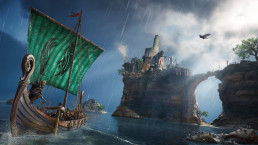
Even during missions, Assassin’s Creed Valhalla is more reserved with its icons and clues. An example, at one point I run into two Normans who want to plunder a house. However, they do not have a torch and therefore cannot set anything on fire. And what’s looting without a bright bonfire? Instead of immediately showing what you need to do, the game leaves it to your own imagination that you can light the thatched roof with a torch.
In another mission, I must uncover a traitor. It is possible to immediately point out a culprit, but you can also interrogate people in the village or follow a whole trail into the swamp. Instead of knowing exactly how many hints you still have to collect, you now have to rely more on your own instinct.
Having to think for yourself is often a lot more fun than just running to the next arrow on the map, but unfortunately Assassin’s Creed is not always suitable for this. “Traditionally” it sometimes happens that you suddenly cannot address a character or that a required object does not want to load. Previously you had realized that it was better to reload a checkpoint, but now you regularly remain in the dark, am I doing something wrong, or is the game broken?
The slight suspicion that something is technically not going quite right is certainly not unfounded. Valhalla has the necessary rough edges. Think of hard transitions between videos and gameplay, missing sound effects or spontaneous, spastic animations. But also at gates and doors that remain closed after respawning, so that part of the men remains behind during a castle storm.
The animations during fighting don’t always look smooth either. There is a strange contrast between how flashy fast Eivor can evade and how slow he throws a flail around. With special attacks, the animations often do not quite match each other, causing Eivor to either fall into the air, or make a very strange jump.
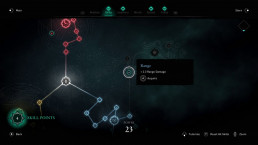
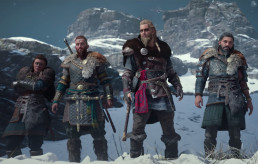
That said, fighting in Valhalla feels very satisfying once you get the hang of the combat system. It is no longer necessary to equip Eivor with new weapons on the assembly line and therefore does not always have to get used to other properties. You will find new weapons with different characteristics, but they are not necessarily better or worse than the one you already have. If you want, you can finish the entire game with the same axe.
The axe, the hammer, The Flail. Each weapon feels different, but each one gives you a sense of unadulterated brutality befitting the Vikings. Flying limbs and decapitations are therefore the order of the day. Valhalla takes some getting used to after the fairly light-hearted Odyssey, but fortunately there was also room for a humorous note in the Middle Ages.
Especially “Flyting” regularly causes a big grin on the face. In these Viking “Rap” Battles you always have to choose a phrase that not only rhymes with what your opponent just said, but also something that fits in rhythm. Eivor does not hesitate to talk about someone’s physical characteristics or mother, but finding the right diss is easier said than done. Perhaps the best side activity is the tactical dice game Orlog. The rules of the game are simple enough that you get it after one time, but complicated enough to keep you fascinated again and again.
That is actually the common thread of all of Assassin’s Creed Valhalla. Compared to its predecessor, Valhalla is a lot easier to understand, with fewer game mechanics, stats and distractions. At the same time, the content that remains is structured in such a way that you as a player are drawn even more into the game world.
Score:
8,5
+ Suitable and cool Viking weapons
+ Pleasant balance between main and side missions
+ Original and fun activities such as flyting and Orlog
+ Missions are less layed out before you
– Several bugs and technical flaws at launch
– Missions sometimes unclear
Review | Watch Dogs: Legion
It's no fun living under the rule of a totalitarian police state where everything you say and do is monitored. Ubisoft finally dares to make a political statement with Watch Dogs Legion and does not bother about it: life in post-Brexit London is miserable.
Nor does it help that freedom-fighting hacker group DedSec is framed for a number of attacks in the British capital. The spy at the head of this group is killed and the rest of his followers are slaughtered in cold blood. However, a small part of DedSec manages to escape and tries to ignite a new revolution via the remaining smoldering fire.
This requires new members of DedSec and in Watch Dogs Legion they can be found all over London. Anyone who is even the slightest bit worried about the occupation of London by the private army Albion can be recruited. For example, DedSec’s new legion quickly becomes a crazy mess, consisting of all layers of the London population. They also each bring their own unique skills.
A heavy drinking retired lady may not be the most obvious hacker, but her high tolerance for alcohol can also take her more blows. A lawyer is more likely to release her henchmen after they are arrested, a specialist hacker has a unique drone with lasers, and a former Albion member can walk into areas closed to the public with his stolen outfit.
By eliminating a regular main character and instead making randomly generated residents of London playable, the third part of Watch Dogs takes an original new turn. All characters are capable of the same thing to some extent. Hacking cameras, cars, drones, doors and computers is as simple as pressing a button for anyone. The difference really is in the few unique abilities each character possesses. To make things even more interesting, Legion also introduces permadeath. If one of the DedSec recruits is killed during a mission, they are really dead for good and another member must complete the assignment.
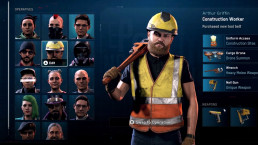
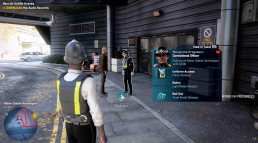
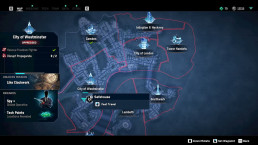
The idea sounds brilliant, but Watch Dogs Legion never manages to fully go for the roguelike-esque elements. The missions are too one-sided for that, for example. Time and time again it boils down to penetrating a base to steal crucial information from a mainframe once inside. There are plenty of ways to get in, which is why which character accepts the mission doesn’t feel so important.
Whether you gain access as a professional assassin or construction worker, it doesn’t really matter, because it is equally easy for both candidates. Since every character comes with numerous gadgets and weapons as standard, you never get the feeling that you have brought the wrong hacker. As a result, switching between the members of DedSec feels increasingly unnecessary as you have more upgrades and gadgets.
It is urgent that the Legion aspect of Watch Dogs is not properly reflected, because the game falls quite short in many other areas as well. As we’re all used to in a Ubisoft game, areas of London need to be liberated. To do that, there are short missions that alternate between sabotage or killing a VIP within Albion. When enough requirements are met, a special mission follows that inspires the inhabitants of an area to take on their occupiers.
However, the difference between a neighborhood that fights against Albion and one that is still being suppressed is minimal.
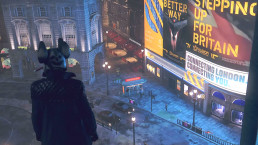
The story, meanwhile, suffers from the lack of a regular main character. The road to the liberation of London feels like a succession of near-future sci-fi clichés mixed with Black Mirror episodes from ten years ago.
Interesting storylines can be found in the screens with information that appear when the hack tool is aimed at a random passerby. As a member of DedSec you get access to all private data of everyone on the street. This way you learn what keeps them busy and what their hobbies are, but also special skills when you recruit them. Notable potential new members can be monitored in this way.
The game is surprising in other ways too. For example, there are areas in missions that are completely inaccessible to humans, but that are visible through smart switching between cameras and drones. As a stealth game, Watch Dogs is now far from brilliant, but the game often has cool moments. Because hacking is effortless, with a few taps on your phone you can turn a quiet checkpoint into a chaos of suddenly enemy drones, parked cars pulling away at full throttle and weapons that suddenly stop working. Legion is a huge power fantasy in that respect and also quite a fun one.
Unfortunately, this third Watch Dogs doesn’t have enough fresh new ideas to keep the whole 15-20 hour long main story compelling. The new elements, such as multiple playable characters, are too superficially incorporated in the rest of the gameplay for that. For example, only towards the end of Legion does a mission pass in which there is mandatory switching between the characters. By then, the whole unique premise already feels wasted on a game that does far too little with it. Add to that the striking amount of bugs, extremely long loading times and crashes and you have a game that simply doesn’t feel quite finished.
Score:
8,0
+ Lots of variation between different characters
+ Beautifull and colorful London
– Switching between characters doesn’t feel necessary
– Monotonous set-up of missions
Review | Mafia Definitive Edition
Shortly after Rockstar seemed to define with GTA 3 what a three-dimensional open world game should look like, Czech Illusion Softworks proved that it can also be very different. In Mafia, you didn't find any distracting side missions and activities, but a tight focus on a crime epic inspired by the works of Francis Ford Copolla and Martin Scorsese, in which taxi driver Tommy Angelo accidentally grows into a "made man". Eighteen years later, it's up to developer Hangar 13 to demonstrate why Mafia has such legendary status.
Make no mistake, Mafia: Definitive Edition is not a simple polish with some new textures and a higher resolution. It’s really a newly made game, with different actors, new and old music, and minor story changes. Especially the “new” Tommy Angelo takes some getting used to. The version, performed by Andrew Bongiorno, is much more of a sleek slick than the actually slightly too soft and sweet Tommy from the original. Now that his love life with Sarah has also been brought into the limelight, the new iteration looks a lot more human. Practical adjustments aside, the story is 99 percent the same.
Everything you can remember about Mafia after eighteen years is in the game. The cursed racing mission which fortunately can now be done a lot better, the infiltration on the paddle boat, the shooting in the parking garage: everything is there. Mafia: Definitive Edition is therefore one big “Oh yes!” Moment. That is, if you played the original.
If not, Mafia: Definitive Edition’s weaknesses are much more noticeable. Take the shooting system for example. Major parts of the game consist of emptying pistols, Luparas and of course iconic Tommy guns. However, you never get the feeling that deadly lead is being sprayed. Impact bullets make an unimpressive sound and bodies barely react when riddled. A traditional settlement therefore comes across as tame, while sometimes you hardly realize that you are under attack yourself.


In addition, the heavily undersized AI is a permanent thorn in the side. During stealth missions, for example, it is completely unpredictable what the enemy will and will not see, but even in shooting and fist fights the AI does not show its best side. Enemies run around like headless chickens, don’t get it when you flank them and don’t anticipate at all when you walk up to treat them with a punch on the clean-shaven cheeks. Incidentally, pedestrians are not much more intelligent, because they’ll simply cross over and over again when driving though the streets. Even in the midst of intense chases with men hanging from windows with submachine guns!
Furthermore, it seems to be random which enemies do and do not appear on your radar, and something graphically can still go wrong. Especially in the already wooden fist fights, an arm, leg or entire body often accidentally passes through a wall. Let’s just say Mafia: Definitive Edition is not technically an impressive game.
Despite this, the strongest thing about the original remains proudly standing eighteen years later. Not only does the story remain strong from start to finish and the new actors deliver a good job, Mafia’s entire zeitgeist is right. The art deco architecture of Lost Heaven, those unwieldy cars that sometimes don’t even go faster than 40 mph, bells that sound like a goose being throated and the old-fashioned music of The Mills Brothers and Lonnie Johnson exude enough atmosphere to fall in love, again.
Another nice detail that cannot be left unmentioned: the police can hand out fines. A mild traffic violation such as a speeding violation or driving a red light will cause the police to come after you, but if you can’t get out, you can just handle it in a civilized way. As a real wiseguy you don’t want any unnecessary problems with the long arm of the law.
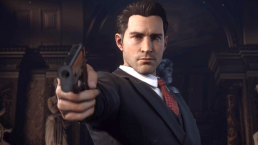
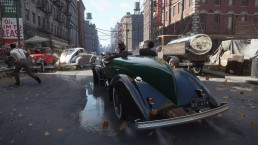
Mafia: Definitive Edition is therefore primarily a love letter to the original, intended for everyone who actually played the original. An accessible way to bring back those warm memories of eighteen years ago, on contemporary consoles and PCs, without having to turn to a GOG version where the music has been stripped out due to licensing problems. If you know how much fun it is humming Chinatown, my Chinatown while tracking down someone who needs to get “greetings” from the Don, Mafia: Definitive Edition is the place to be.
Mafia: Definitive Edition is now available for PC, Xbox One and PlayStation 4. For this review, the game was played on a PS4 Pro.
Score:
0,0
+ Intriguing and well-interpreted story
+ Intense atmospheric world
+ A complete and fresh remake, not just an upgrade
– Shooting system lacks impact
– Substandard AI
Review | Marvel's Avengers
Developer Crystal Dynamics has made it clear that Marvel's Avengers must become a living universe. With a cooperative multiplayer mode that is constantly updated with new content, Marvel’s Avengers should last for years. The story mode intended as an introduction and the cooperative multiplayer are qualitatively far apart. It's surprising that the "single player mode" is the signed winner.
The narrative part of Marvel’s Avengers knows how to perfectly respond to the inner Marvel fan by not putting someone like Captain America or Iron Man at the center, but rather the young superhero-in-the-cap Kamala Khan. The fantasy trip for Marvel fans kicks off right when Kamala enters Avengers Day, sort of an open-air Marvel convention. The biggest difference is that the visitors do not marvel at cosplayers, but at the real superheroes in the flesh. If the future Ms. Marvel suddenly bumps into Thor, she’s not the only one who squeaks with enthusiasm.
However, that euphoria is short-lived. The Avengers giant airship goes up in flames after an attack. The nasty stuff that is released during this process turns Kamala into the very flexible Ms. Marvel. Then a classic origins story unfolds, in which Kamala not only discovers her own super powers, but also brings the fallen Avengers back together.
Although the story does not really surprise, it is a succession of fan material. In addition to Kamala, you regularly get the other Avengers under your control. They all have roughly the same type of attacks, such as a light and a heavy attack and a remote attack. But where Iron Man, for example, shoots with his repulsors, Captain America throws his shield , Thor with his hammer and The Hulk just pulls a fresh piece of debris from the ground towards the ill-fated enemy.
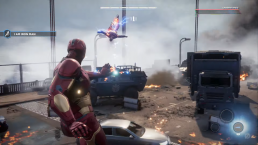
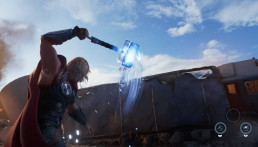
The unambiguous controls allow you to switch effortlessly between the different heroes, but you can also take the time to master a specific superhero. The story mode is not nearly enough to unlock all skills for the different heroes. This game is made to last much longer. The multiplayer DNA is deeply rooted in Marvel’s Avengers and the narrative part cannot be separated from the cooperative battles.
For example, during the “single player” you will be presented with missions several times that you can play with multiple players. If no partners are found through matchmaking, computer-controlled heroes fill in the blanks. These missions are immediately out of tune, the environments stand out against the locations you play through on your own, objectives are generic and the interaction between the Avengers lacks the credible touch that Kamala and Bruce Banner put on the stage in the beginning.
It is a shame that it has been decided to put so much emphasis on multiplayer, because at the moment there is a lot of fun to be had in Marvel’s Avengers, especially as a single player game.
That line continues unabated once you launch Avengers Initiative: the real multiplayer part of the game. This is set after the campaign, when the world is still plagued by various threats and the Avengers are needed everywhere to quell conflict. Some missions are done in minutes, others take considerably longer, but none of the online activities really surpass the single player.
Interiors are eagerly reused and usually have the ambiance of a dental practice. Usually the ultimate goal is to smash a few generators, defend a few checkpoints, or protect a few S.H.I.E.L.D agents. In addition, you should of course punch everyone you meet in the face, because that is what Marvel’s Avengers is all about: fight and fight, preferably as spectacular as possible.
Sometimes that results in unadulterated superhero fun, sometimes the chaos simply becomes too much. When vibranium shields, divine hammers, green fists, bullets, lasers, debris, robot parts and outstretched limbs fill the screen, it’s not just your eyes that struggle to keep up with the chaos.
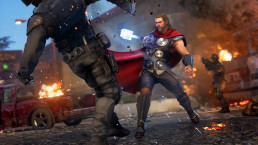

Nevertheless, there is enough in the barrel for any superhero. In addition to the missions and routine gear upgrades, there are also daily and weekly challenges that earn you points as part of the Hero Challenge Cards. You can complete those challenges anywhere. In a story mission, online, on your own: everything counts. This way you can unlock new costumes, emotes and name tags per character. The game only gets a bit of an appearance because you can also unlock everything in the Challenge Cards with real money.
If the online activities were really cool and you enjoyed playing them over and over again, that was until then. But now that the missions are also repeated after a short while, you have to grind a lot to complete the Challenge Card and thus unlock all costumes.
Marvel’s Avengers really does need some work to break through online. In addition to the fact that the missions get boring relatively quickly, the game is not entirely perfect technically. Sometimes you fall through the ground, enemies end up in closed environments and there are quite a few graphical oddities in the game. Crystal Dynamics will add new characters in the coming period, including Hawkeye, Kate Bishop, Black Panther and, exclusively on the PlayStation, Spider-Man. That will only make Marvel’s Avengers attractive to more people, as playing as your favorite Marvel hero is the game’s biggest draw.
The fighting system is right, the powers are right, the balance is right: every superhero is fun to play with. The heroes’ designs are debatable, but the unlockable costumes solve that problem for most people. It is a shame that it has been decided to put so much emphasis on multiplayer, because at the moment there is a lot of fun to be had in Marvel’s Avengers, especially as a single player game. The multiplayer is now on level The Incredible Hulk (2008). Let’s hope it doesn’t take Crystal Dynamics eleven years to reach level of Endgame.
Score:
8,0
+ the “single player” turns out to be surprisingly good
+ Great sound and special effects
+ Every superhero is well put together with their own moves and custom costumes.
– Overly cluttered War Table
– Multiplayer recycles content
– Various technical issues
Review | Ghost of Tsushima
At Sucker Punch they could have just shouted "If Ubisoft won't do it, we'll do it!" in their conference room. Ghost of Tsushima is very similar to Ubisoft's showpiece. The main difference is something that many a fan has longed for, feudal Japan as the main setting. I myself have waited long for this and am very glad with the upcoming AC Valhalla but the feudal japan setting is something I've longed for for a verry long, long time.
Players take on the role of samurai Jin Sakai, during the Mongol invasion of Japan in the late thirteenth century, Jin’s island of Tsushima is the first place where the war breaks out. In the action-packed opening scene, Jin and his companions are defeated by the Mongol warriors, for whom no tactic is too cruel. This defeat makes it painfully clear to Jin that the traditional, honorable way of the samurai is not enough to defeat the Mongols. He has to become the Ghost of Tsushima.
Jin therefore constantly learns new fighting styles. He is already a skilled swordsman and quickly handles the bow ,with great finesse. But also less “honorable” weapons such as poison arrows and smoke bombs are part of his ever expanding arsenal to fight the Mongols. Moreover, Jin learns how to silently commit assassinations, for example by striking from the tall grass or by jumping on someone from a roof.
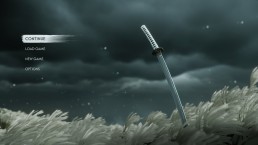
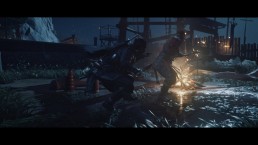
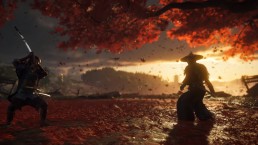
Ghost of Tsushima consists largely of fighting, which is very rewarding. The combat system seems simple, with a normal and heavy attack and a button to block or repel. However, Jin has different fighting stances that are effective against different types of enemies. Therefore, you would prefer to attack an enemy with a spear in a different fighting position than an enemy with a shield.
It takes patience and practice to master the system, let alone throw a smoke bomb in a fluid motion and aim an explosive arrow between someone’s eyes. However, as soon as it works out you’ll feel very powerful. It’s graceful if you combine all the different elements perfectly and efficiently turn your enemies into sashimi.
You will always encounter an opponent who is just a bit faster or smarter. Sucker Punch does not choose the cheap solution where an enemy that looks exactly the same is suddenly unbeatable because it has a higher level. Some enemies wear visibly heavier armor or suddenly wear a helmet, while some swordsmen sometimes surprise you with a slightly different fighting style. In addition, the game regularly presents you with one-on-one duels that require more concentration. The differences in enemies are more subtle than in many peers, so you can’t play simply on autopilot. You’ll have to keep adjusting your play style.
Jin’s adaptability is also an important element in the story. That is not only about the struggle with the Mongols, but also about his inner struggle, he gives up the honorable way of the samurai to protect his homeland. Not only does that fit the theme well, it also creates a nice dynamic with other characters who are all affected in their own way by the Mongol invasion.
Jin gathers a group of likable characters, each with their own storyline that runs parallel to the main story. That makes these side missions more interesting, because you get to know the main characters better. At the same time, this bond with the side characters reinforces the main story.
The game also has a nice rhythm, which automatically creates space for these side missions and the other activities on the island. Ghost of Tsushima is divided into clear deeds, so you know well what an appropriate time to do side missions and when you can prepare for a big confrontation. Fortunately, the story is not predictable. Ghost of Tsushima throws enough surprises at your feet to captivate and move you to the end.
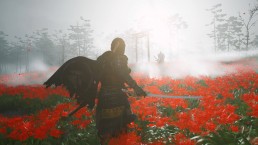
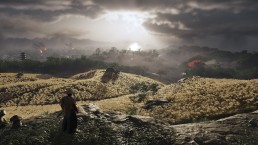
The rest of the side missions and other activities are almost always a repeat of moves. Helping villagers, freeing settlements or just fighting with a Mongol patrol remains fun for a long time thanks to the strong fighting system. The so-called Fox Dens, on the other hand, become repetitive after a few times. Here a fox leads you to an altar, but this tune is exactly the same time and time again. Writing a haiku has been found funny, although it ultimately consists of choosing no more than three sentences that appear on the screen.
Outside of these activities, Tsushima looks somewhat empty and old-fashioned. Climbing is only possible in the designated places and the people of Tsushima hardly respond to your presence. Villagers usually don’t even have a routine and just stare in front of them.
For example, we gave a group of refugees access to a temple by speaking to a monk, but received no rewards or thanks. Another time we knocked out a Mongolian catapult and received some raw materials from the locals as a reward. A trail of dead foxes and deer, on the other hand, led to nothing. Sometimes it is as if the development has stopped in some places.
The game world itself, on the other hand, is beautifully designed. Sucker Punch does not aim at photo-realism, but romanticizes and exaggerates the image we have of Japan. The shimmering moonlight and the dazzling rising sun are beautiful to see. Colorful flower fields dance in the wind and so many leaves and pollen float through the air that you spontaneously get hay fever.
Lovers of classic samurai films can switch on the Kurosawa mode so that everything is monochrome and the sound creaks old-fashioned, but that is actually a waste of the beautiful colors and also of the atmospheric, authentic music! The game, on the other hand, also has the option to turn on extra dramatic contrast, if the colors aren’t bright enough yet.
However, the landscape not only functions as eye candy, it also has a practical use. Most open world games do have something of a map or radar in view, but Ghost of Tsushima solves it differently. The wind always blows in the direction of your goal, so you just have to look at the swirling leaves or the swishing grass to know where to go.
There are also golden yellow birds that lead you to special places. This could be an undiscovered side mission or activity, but also a new headband or hat. Fireflies from afar indicate that there is something to do somewhere and if you give a bow in the right place, butterflies, fish or leaves will whirl around you. Ghost of Tsushima is an almost spiritual experience at such moments.
Score:
9,0
+ Beautifull, detailed & wonderful world design.
+ Side missions interestingly intertwined with the main story
+ Fast loading times
+ Refined fighting system
– The game world occasionally looks empty in certain areas.
– Many activities are repeated and might come less interesting
The game has been tested on a PlayStation 4 Pro. Ghost of Tsushima is available on PlayStation 4 from July 17.
Review | The Last of Us: Part II
The Last of Us: Part 2 again did what it promised and is the most beautiful story ever told in a video game. This zombie game is not about zombies or Infected. This game is about people. The Last of Us 2 holds up a mirror to humanity. And the reflection is not a pleasant sight.
At the beginning of the game, the main characters from the first part, Ellie and Joel, live in Jackson. They are part of a group of people who act as a community against the dangers of the outside world. It’s quite a nice place to stay, with beautiful forests, a playground for the children and even electricity to charge your walkman. Ellie is having a good time here and even finds love in Dinah, but happiness in this world is always short-lived.
A drama unfolds, after which Ellie heads to Seattle for revenge. It is essentially a simple story, just like in the original. It is the human storytelling that takes The Last of Us 2 to an unprecedented level. Ellie, Dina, Joel and his brother Tommy, they are all credible people who may not make the perfect choices, but are pure in their intentions. They are all people. Real people. And they have to do really inhumane things. The fact that the voice acting and motion capture is on point as always really helps in bonding with your character.
All of this is acted extremely well. Ashley Johnson, in particular, can be awarded this year, because her Ellie is truly phenomenal, again. It’s a difficult task to combine such a tough character, which eliminates strong opponents as if it were nothing, with a sensitive woman who drags a lot of luggage. Fortunately, Johnson knows to strike exactly the right tone: fragile if necessary, bone breaking if possible.
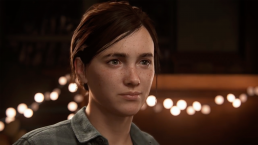
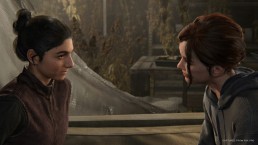
The grim message of the game is extended to combat. Blood splatters around the place and screen, Infected are cleaved without mercy and the many finishers are shown relentlessly. After you injure the last enemy in an area, he begs on his knees for his life. That does not stop Ellie from still getting the job done with a baseball bat, or any other weapon for that matter. At least, if you make that choice. After all, you are and remain only human.
All that violence starts to gnaw at you as a player. It gets in your head. Naughty Dog clearly has that effect in mind. Human guards call each other’s names and become audibly nervous when they can no longer find each other. Dogs moan when hit by a Molotov cocktail. And just like you, Ellie has a hard time with that. Every gutted throat carves a scar on her soul.
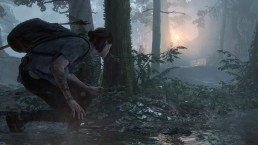
Everything in this sequel serves the human aspect. No single game element escapes that eye for detail. Seattle is beautiful, but completely destroyed. Each abandoned house with its unique interior tells its own story about the residents. Ellie visits abandoned offices, banks, aquariums and hospitals, and they all have their own atmosphere. Sometimes you stand in wonder for five minutes in the dressing room of a theater, maybe at the dozens of unique costumes, maybe at the walls covered with posters of bands that have ever performed there. The music store filled with albums and posters of the latest releases, at least at that time.
There is hardly any UI to pull you out of that world. Screen info is rarely to be seen. The game inventively uses the environment to pinpoint the next target. Light, for example, shows you the way, or the sound of your next enemy. In a certain section you have to go west, and it is noted that you can follow the setting sun. It is a very natural way to play a game. Disturbing waypoints or mini-maps are a thing of the past.
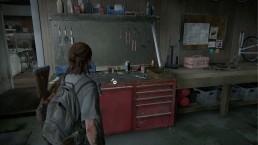

For a linear game, The Last of Us: Part 2 offers a lot of freedom. Not only in the way you fight, but also in exploring Seattle. You do not have to enter many buildings, but if you don’t want to run out of ammunition, it is worth going on a looting trip. It’s not very exciting to open drawers and cupboards all the time in search of stuff and bullets, but that just goes to show that Ellie needs all the tools she can get. In addition, background information or exciting battles can often be experienced in these optional areas.
The game has negatives. It has happened a few times that a companion got in the way. These AI-driven companions sometimes even tap you out of cover, making you noticed by an enemy. The hint system can also be painful. With a loud sound, the game makes it clear that you can get a hint if you don’t know where to go, while you are still looting the rooms. Fortunately, you can completely disable that system.
It is hardly noticeable. All systems, environments and story elements merge seamlessly. The fluid combat with which you can improvise unhindered plays wonderfully. The eye for details drags you all along in the game world. But in the end it is mainly the story that makes the most impression. The Last of Us: Part 2 is a game about people even more than other games. This game tears you up with emotional scenes, impactful moments and a grim look at what it means to be human, regardless of the background.
Score:
9,5
+ Smooth combat.
+ Beautiful environments.
+ Excellent story and acting.
+ Allot of attention to the smallest details.
– Annoying hint system
– Artificial intelligence sometimes gets in the way
Review | Dragon Ball Z: Kakarot
After years of multiplayer games, there is finally another Dragon Ball Z title that focuses on the fans. Kakarot is an RPG, which unfortunately cannot compete with its genre mates.
It has been over fifteen years since Buu’s Fury appeared for the Game Boy Advance. It was the last ‘real’ role-playing game based on the Japanese animation series that, despite moderate criticism, still has a warm place in the hearts of Dragon Ball fans.
Developer Cyberconnect2 is now trying to respond to that sentiment with Dragon Ball Z: Kakarot. In recent years, the studio has been responsible for the .hack games and recent Naruto fighters, making it the main supplier for games based on Japanese anime. With Kakarot they aim at a large scale: the game covers the full story of Dragon Ball Z, from the arrival of Raditz to the fight against Majin Buu.
The combat system is a bit like that from earlier 3D fighting games in the Dragon Ball series, such as Budokai Tenkaichi and Xenoverse. You fly around in a three-dimensional environment, where you string simple combos together and fire powerful super attacks. In Kakarot, the system has been slightly modified to give it more of a role play feel, so that you can block during an enemy attack, for example.
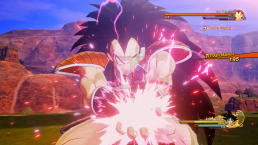
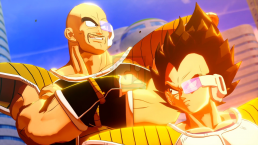

Kakarot has a kind of open world. The game is split into several large areas, through which you can walk or fly. There you can start side missions, find food and resources and fight strong monsters flying around.
Almost every mission that you play alongside the main story, is the same. You’re asked to collect some materials, which you then hand in for a reward. Although the areas in the game are large, they sometimes feel a bit empty. Every region is filled with floating Z orbs, which you can collect to buy new upgrades.
It can be tempting to fly into the world and eliminate random enemies, to gradually make your characters stronger. Kakarot profiles itself as an RPG, one that constantly tempts you to save points for new super attacks and other skills, but you will be disappointed after you have tried this. All optional content gives extremely few experience points, while continuing to play the story makes you grow enormously fast in level.
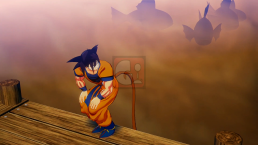
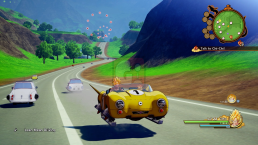
It may be clear, Kakarot presents itself as a role play, but in reality it gives you hardly any control over the growth of your characters. This is also reflected in the way you unlock new attacks. You can purchase upgrades through an extensive skilltree, but after a few investments it ends: you have to reach a specific chapter to unlock the rest. The game basically just wants you to ignore the entire RPG system and simply follow the story.
We understand that to a certain extent: after all, you don’t want Goku to become Super Saiyan after long grinding, even before his best friend is murdered by Freeza. But it probably proves why the story of Dragon Ball, which relies on the heroes’ power-ups and new attack techniques, does not lend itself to role-playing such as this one. If Kakarot had its own story, that would lead to a freer and more creative game.
Score:
8,0
+ Story of the whole Dragon Ball Z universe
+ All the favorite DBZ characters are included.
+ Graphic style looks amazing, cartoon like.
– Empty world during free-roam
– Undermines its own RPG systems
Dragon Ball Z: Kakarot is now available on PC, PlayStation 4 and Xbox One. For this review, the game was played on PlayStation 4 Pro.
Review | Pokémon Sword & Shield
When Pokémon created an unprecedented craze in the Western world at the end of the 1990s, many assumed that this would be short-lived. Anyone visiting a random schoolyard today would almost say that time has stood still ever since. Pokémon is alive and kicking and in 2019 just as relevant as twenty years ago.
Due to this popularity and the unprecedented success of the Nintendo Switch, it was a matter of time until we were able to welcome a new Pokémon game to this versatile gaming console. After previews in the form of Pokémon Let’s Go Pikachu and Let’s Go Eevee, Pokémon Sword and Shield’s job is to provide today’s Nintendo hardware with a full-fledged Pokémon adventure. That adventure is one that has certainly been inspired by the success of Pokémon Go and the earlier Switch titles, but with all the familiar elements of the past.
The core of the series is therefore unchanged in Pokémon Sword and Shield, as a brand new Pokémon trainer you set out to add as many cool creatures as possible to your collection and to raise them in an attempt to make it as a Pokémon master together. To achieve that title, you must become a Pokémon League champion and for that you must first defeat eight particularly talented gym leaders. This storyline is as old as the series itself. During your journey through the new Galar region, however, this journey to the championship title is more central than before.
That also provides a particularly pleasantly streamlined experience. With a single goal in mind, there is suddenly noticeably more room for free exploration and discovering the many Pokémon that can be found all over the world. Many small improvements have also been added to ensure that your adventure is not unnecessarily interrupted, unless you choose to do so yourself. For example, no special skills are needed to bypass annoying roadblocks. In any Pokémon center you can rename your Pokémon, have attacks forgotten or remember them without any further conditions. You don’t have to go there this time to change team members. Now you can exchange your Pokémon at any time from the main menu. The same goes for the return trip to previously visited areas.
This time it is also made easier for players to grow and train Pokémon. Many of the more profound elements that were previously hidden behind unclear game mechanics are now much more accessible. Most players will hardly notice this, but for fans of the competitive element of Pokémon it is a relief that aspects such as abilities, natures and individual values are now extremely easy to adjust.



All these small improvements greatly benefit the experience, but are subordinate to the magic of the game world and the fantastic monsters that can be found in it. The feeling of being allowed to discover a big world, where new, unknown creatures are appearing in every forest and on every plain, is timeless. Pokémon Sword and Shield are doing well in this regard. The Galar region is an area whose design and folklore are clearly based on the United Kingdom. This means that during your journey you will travel through industrial areas, grassy plains full of Wooloo’s and rolling hilly landscapes that are each depicted in an impressive and completely characteristic way.
The Pokémon that populate this idyllic island are also inspired by nature or legends that we associate with our overseas neighbors. Consider, for example, the aforementioned Wooloo, an endearing little sheep, or perhaps even rather Yamper, who resembles a Welsh corgi. With matching curiosity, these creatures roam the lawns of Galar, where players can see them walking from afar. By incorporating Pokémon into the game in this way, they feel much more like an organic part of the game world.
In addition to normal flora and fauna, there are also Pokémon that are based on unicorns, goblins and other supernatural beings. The vast majority of these new designs have been very successful. Both the pokémon and the Galar region themselves are the undisputed stars of the games. With so many great designs, it is almost impossible to limit yourself to only six pokémon, especially when the excellent balance with which new faces and old acquaintances are spread throughout the game world ensures that each route or new area offers something new and unexpected.
Despite the fact that it is full of well-known Pokémon, there is still a reasonable chance that your personal favorites are missing. In Galar there is apparently no room for more than eight hundred different creatures, leaving a large part of the well-known Pokédex unfilled at the end of the game. While playing this is no problem, there are still so many different Pokémon in it and it is nice that this way the new creatures also get the chance to shine. It is also not exactly a new development, in earlier game worlds of the series, the set of native Pokémon was always limited. Only after completing the storyline did you unlock the ability to expand your Pokédex, often by transferring Pokémon from previous games.
But it is precisely because of the lack of that last possibility that many fans have been put in a stir before the release of the game. Game Freak has already announced that even at a later stage transferring Pokémon from other games will not be possible that the available Pokédex is actually limited to what you can bump into during your adventure. That is quite a damper for a game from 2019, of which you can expect that there are numerous possibilities to meet this need.
Game Freak knows how to deliver a great Pokémon adventure with Pokémon Sword and Shield, but fails to introduce substantial innovations. The games may come out on the Switch, but they still feel a bit like glorified 3DS titles. Pokémon, for example, still have half-hearted combat animations, and cities are often somewhat empty and quiet. One of the most important new game additions, the Dynamax system, also makes little impression. Pokémon can only activate Dynamax in certain battles, after which they become huge and much more powerful. Although this only takes three turns, the increase in strength is absolutely significant. By ignoring it you shoot yourself in the foot. That is interesting for fights, but does not appeal to the imagination. Pokémon, with a few specific exceptions, only become very large and that is especially drowsy. After the introduction of Mega evolutions and Z-Moves, this really feels like a disappointment.
The Wild Area is a lot more successful in that regard. The area functions as a kind of freely accessible Safari Zone where there is much to explore and all kinds of rare and constantly changing pokémon. The feeling of freedom and the ability to keep coming back here and finding something new is a welcome refreshment. However, the Wild Area is still relatively small and not very varied visually, which makes it seem like it’s just an experiment to add a real open world to a Pokémon game. Everything goes with baby steps within the Pokémon franchise. Game Freak clearly considers the series not yet completely ready for an actual open world, but perhaps the Wild Area is a nice pass for the future.

If the developers had paid just a little more attention to finishing their new ideas, then Pokémon Sword and Shield could have been one of the ultimate Pokémon games. That, incidentally, says more about the quality of the series in general, because, after all, it is still a very entertaining game. Fortunately, the technical imperfections and the lack of genuine innovation hardly disturb. After all, Pokémon is ultimately about collecting cool, sweet, tough or kiddy little monsters that know how to steal our hearts.
Pokémon Sword and Shield will be available on Nintendo Switch from 15 November. Pokémon Shield was played for this review.
Score:
8,0
– Fairly limited Pokédex.
– Not technically impressive.
– Dynamax is a moderate and somewhat boring feature.
+ Galar region is beautifully designed.
+ Cool new Pokémon designs.
+ Sharp focus in storyline
